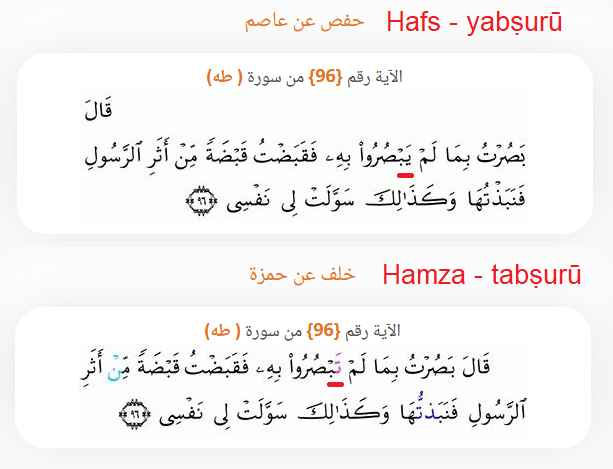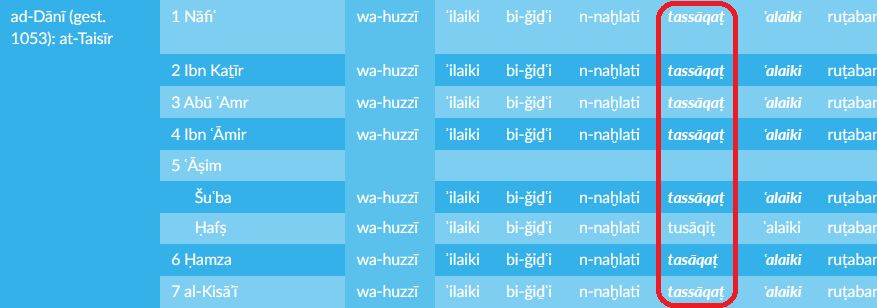It’s easy to find examples of variants in the Hafs vs Warsh recitations of the Quran or the Sanaa manuscript, but what happens when you look at the readings in general? Are they mutually compatible? Does the variety always have a plausible purpose?
It’s not easy for your typical English speaker to directly access other readings. That changed in 2020, when the Bridges translation of the ten qiraat of the Quran by Fadel Soliman was published and also made available on the quran.com website. Now the whole English speaking world can access variants in the ten canonical readings.
We’ll be looking at some examples in this article, as well as some relevant developments in the academic world in 2020 and 2021.
This video shows some ways of using the Bridges translation on quran.com The examples in the video surprised many of the viewers and there were some interesting Muslim reactions. Both involve dialogue variants which affect the words a character is portrayed as saying at some point in history (these and more such examples can be seen in this article).
Quran 17:102 in the Bridges translation reads:
He said, “You have most surely known that none sent these down except the Lord of the heavens and the earth,(as) insights. And indeed I think that you, O Pharaoh, are doomed to demise.”
Here Moses is arguing with Pharaoh. However, in the reading of al-Kisa’i, Moses instead at this point of the story says, “I have most surely known”.
One reaction has been to suggest Moses said both to Pharoah. Supposing the exodus myth really happened, both sentiments could have been expressed and work in a Quranic context. But it’s a very tough sell as an explanation for this variant. Whether regarded as verbatim translation, paraphrase or fiction, the author chooses to portray a story involving a dialogue, an argument between two characters. This variant is tightly embedded within that dialogue and would create a significant contradiction with his existing portrayal as part of a specific utterance. It occurs for a verse already revealed, changing only a single verb subject. This isn’t one of those cases where a story is retold afresh with different words somewhere else in the Quran. It looks exactly like a glaring and obvious corruption, while the idea of deliberately conveying such a thing in the way suggested is intuitively absurd. Surely it would not be beyond the wit of the author to convey both sentiments in a common reading had that been intended.
The 2nd example — Quran 20.96 in the Bridges translation reads:
He said, “I perceived what they did not perceive, so I grasped a handful from the messenger’s traces and I flung it away, and thus my soul prompted me.”
Here Samiri is replying in a conversation to Moses. The Kufan readers Hamza, al-Kisa’i and Khalaf read him saying: “I perceived what you[plural] did not perceive . . .”
In this example we have two problems. Again the qiraat do not agree on what Samiri answered at this point, but one of the variants is also redundant. Since we have the reading “I saw what you (plural) did not see”, i.e. Moses and the people, what use is there in the other reading, “I saw what they did not see”, i.e. just the people? It’s redundant. In fact large numbers of variants are like this where one variant is made redundant by another or is in other ways superfluous. This is not what you’d expect of divine revelation, but rather a major unrecognised problem for dogmatic views of preservation. Many more types of superfluous variants can be read in another of Avnar’s articles.
Quite often viewers responded that the Arabic text is the same in all the readings, or these are just differences in the English translations. It’s true that all the canonical readings share the same rasm (or almost — more on that later), which is basically the skeletal text, but in written form the readings differ in terms of the dots to distinguish consonants, short vowels and other diacritics. The rasm alone is far from sufficient to perfectly preserve the Quran. We can use the nquran website to illustrate this.

In the above example of verse 20:96, we see that the dotting of the verb subject prefix (underlined in red) makes it a ya- or ta- depending on the reading — “they perceived” or “you [plural] percieved”. In fact the bulk of the few hundred consonantal dotting variants are person or gender prefixes like this one, no doubt as those are the rasm letters most open to interpretation.
Here’s what a typical early manuscript looks like for this verse (Wetzstein II 1913, folio 122r). You can see that the rasm lacks marks to differentiate the consonants (the arrow points to the word we’ve discussed). These were only supplied very sparsely as small dashes in early manuscripts like this one.

In the 17:102 example it’s a final vowel change ʿalimta vs ʿalimtu (try it yourself on nquran by changing the url given above to see other verses).
Let’s look at one last example. There are cases where we have an inexplicable variety of variants (this one is also mentioned in the superfluous Quran variants article). Is such variety really deliberate? Let’s look at verse 19:25 using the Bridges translation.
And shake the trunk of the palm tree towards you — it will drop ripe dates upon you.”
The Bridges translation mentions one of the variants in the footnote: Yaʻqub read it as: “. . . it (masculine — referring to the trunk) will drop . . .” All others read it as: “. . . it (feminine — referring to the palm tree itself) will drop . . .”
This is already a needless variant (Yaʻqub was one of the three readings canonized some centuries after the seven), but there are others among the canonical readings, though harder to translate. In these the palm tree is the (feminine) subject of the verb, and where Hafs has Arabic verb form III, the others have form VI or consonant assimilation (see Nasser’s variants morphology data here or the discussion on p. 34 in this paper).

The Corpus Coranicum page shown in the screenshot also has numerous non-canonical readings including more with the masculine prefix and even the 1st person plural (such as “We will cause to drop” which also occurs in verse 34:9). While same may be matters of dialect, others are certainly not and this is an extraordinary variety for one simple word. It looks like there was much uncertainty in the reading.
Okay, it’s hard to resist throwing in a link to one last example where in some Kufan readings Allah is “amazed” (which goes back to the reading in Kufa of Ibn Masud). This one also illustrates that even the Bridges translation is embarrassed about some of these variants. The Arabic verb is actually the same in both versions, but a final vowel changes the subject.
Another response to variants like these is that the whole Muslim world agreed on these readings. That’s true, but it took centuries for them to become treated as unquestionable. Many variants and even some readings now considered canonical were criticised by eminent figures before the 5th century. If you haven’t heard about Professor Shady Nasser, check out his work on this topic and the difficulties that the Qurra (reciter) community had with many words. There are lots of videos and interviews online, and Avnar’s articles have some quotes from Nasser’s books published in 2012 and 2020 as well as other information on the topic.
Scribal errors in the original Uthmanic copies and other developments in 2021
Now we mentioned earlier that the rasm is “almost” the same in all the canonical readings. Hythem Sidky’s paper On the Regionality of Qurʾānic Codices was published in 2021. He raises the bar on earlier work confirming the main traditional account that Uthman produced four Quranic codices for Medina, Syria (probably Hims), Basra, and Kufa. The earlier work was based on reported variants between these regional copies. Hythem confirms this both using manuscripts and an improved list of variant reports. Separately, he has also argued convincingly that these should be regarded as scribal errors, which is a common view in academia. The arguments are briefly listed in the 2nd half of this article, where you can also briefly read about other academic developments in 2021 involving the Sanaa manuscript as well as the dialect revealed in the Quranic consonantal text vs the canonical readings!
Note that these scribal errors in the Uthmanic rasm are far more significant than the variants in subsequent copying that Dr Daniel Brubaker talks about — we are talking here about variants in the original copies which are treated today as divine revelation by those who take the orthodox and dogmatic view.
So we have different classes of variants in the canonical readings. The scribal errors in the original rasm copies, which generally featured in the readings of those regions, and the much more numerous variant readings of other words in the same rasm. Beyond that there were thousands of non-canonical variants (see this Resources page).
Now, to share one final thought: the 1000+ canonical variants fit within the Uthmanic rasm (canonical readings had to do so). If they all pre-date the Uthmanic standardization and go back to Muhammad, then these canonical ones that fit the rasm would have to be just a subset of all the variants he really uttered (as illustrated by reported companion variants, which are not constrained by the standard rasm). So how many more thousands are we talking now? We are also assuming here that the canonical variants are not just entirely authentic, but are the only authentic variants that happened to fit the standard rasm, which is not a position taken by Islamic scholars. Here it’s worth considering that al-Khatib’s Mu’jam al qira’at compliation of canonical and non-canonical variants runs to a dozen volumes. The mind boggles given that there are only 77,000 words in the Quran. With these two considerations, for the canonical variants to be entirely authentic implies a revelation scenario that sounds chaotic and lacking in any credibility to say the least.
Thanks to Avnar for help with this post. Check out his Quran Variants site which has a few articles with further details on the points covered here and more. There are also now numerous video clips, lectures and interviews on youtube where you can learn in depth about Quran transmission from academics like Shady Nasser, Marijn van Putten and Hythem Sidky if you so desire. Their research and areas of expertise now attract considerable wider interest!
Wow ……!! Mashallah very informative content.